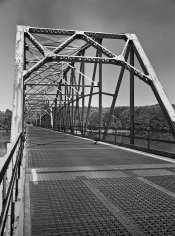BAB
Member
- Joined
- Mar 14, 2010
- Messages
- 32
- Format
- Multi Format
I bought a Fuji GA645 a few months ago, based on advice here, and I must admit the camera is fun to use and gives good results. I recently purchased a scanner, an Epson V500, and can finally begin to play. I've noticed some developer problems though, and wonder if any of you might offer a suggestion for minimizing this particular difficulty.

One can see the differences in density along the top rail of the bridge. A friend has indicated this is probably an agitation issue, and commonly occurs with a plain-sky background. This is Tmax 400 and I developed it in Diafine using a tank with a plastic spool. This was one of the last frames on the roll and consequently quite close in to the center of the spool. I agitated using one turn backwards every one minute. I'm wondering if using a tank with metal spools and agitating by slowly raising and lowering the film with a spool lifter-outer would correct the situation.
Thanks in advance,
BAB

One can see the differences in density along the top rail of the bridge. A friend has indicated this is probably an agitation issue, and commonly occurs with a plain-sky background. This is Tmax 400 and I developed it in Diafine using a tank with a plastic spool. This was one of the last frames on the roll and consequently quite close in to the center of the spool. I agitated using one turn backwards every one minute. I'm wondering if using a tank with metal spools and agitating by slowly raising and lowering the film with a spool lifter-outer would correct the situation.
Thanks in advance,
BAB



